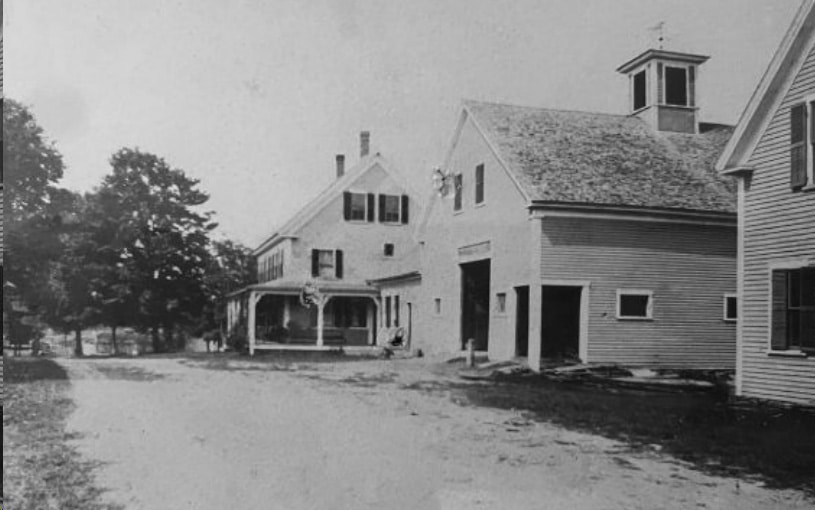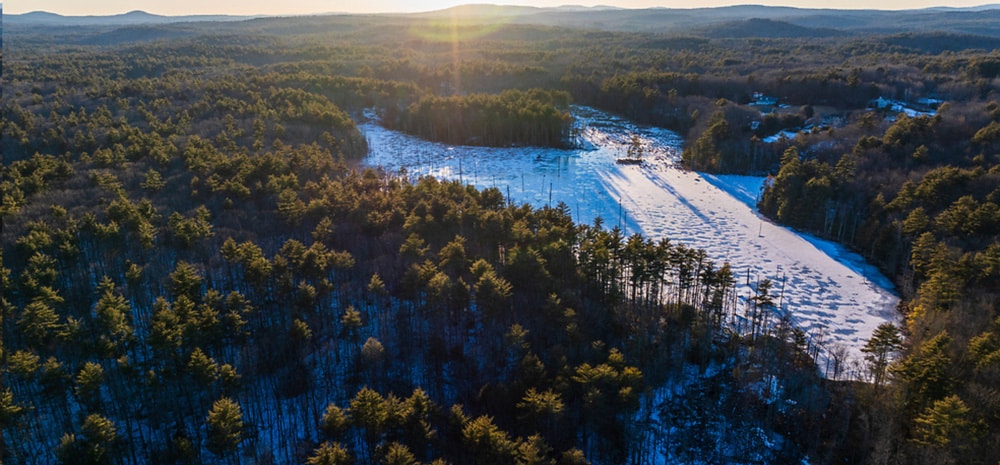Written by David Johnson
Photographed by Jerry Monkman
How one man went from the Civil War battlefield to the Barrington farm field, and charted a path to a contemporary conservation mosaic.
December 18, 1862.
Amidst the chaos and cannon fire of the Battle of Fredericksburg, Sergeant Elisha E. Locke stood shoulder-to-shoulder with his fellow New Hampshire Volunteers. One of 200,000 combatants in the battle, his regiment faced withering fire from a dug-in Confederate army led by Robert E. Lee and his Lieutenants Jackson and Longstreet.
A wound taken on the battlefield felled Elisha, permanently forcing him out of the Civil War. After recuperating in Providence he returned to his hometown of Barrington, NH, in March 1863. In 1869, he bought a farmhouse alongside Ayers Pond at the end of the road that today we call Route 202.
He developed a successful business selling grains to breweries, then had a profitable enough timbering business in the late 1880s, enabling him to enlarge the farmhouse in the 1890s. At the same time, the state promoted early summer tourism to help farmers stay in business.
For Elisha, the proximity to Ayers Pond and perfect for this business, and it also evened out his income. Timbering was done in the winter and sawing was done in the spring. Having summer boarders and renting cottages evened out his income.
He would meet the trains in Dover and then transport vacationers by wagon or automobile to the lake. By 1896, he was successful enough to double the size of the farmhouse, creating a classic New England connected farmhouse.
And that’s how Elisha Locke became one of the founding fathers of the New England agritourism industry.
“I grew up with conservation,” says Hilary Parkhurst, Elisha’s great-great-granddaughter. “For our family, it was always about keeping the land together.”
That commitment to protecting the legacy of this unique family tree reveals itself in the way Hilary relates the story of
Elisha’s proto-AirBnB endeavors. She enthusiastically describes the experiences of the visitors (including the scenic, horse-drawn sojourns on bumpy New Hampshire roads) and the amenities that awaited them (an icehouse, a farm stand, and a cutting-edge central outhouse).
“He would add cottages and buildings over time,” she says. “North Barrington was a popular place for vacationing.”
The Locke, now Bedford, family lands are scattered throughout Barrington, with a large portion located adjacent to
Ayers Pond and the family farmhouse. Now, nearly 150 years later, the lands that Elisha and his family had assembled have been permanently protected.
SELT’s conservation journey with the Bedford family originally began in 2010, when the Strafford Rivers Conservancy (who merged with SELT in 2014), acquired 230 acres around Stonehouse Pond from the Bedford family. This land created the nucleus of SELT’s now-1,700-acre Stonehouse Forest.
The Bedford project consists of three separate tracts that, when taken together, add up to nearly 160 acres of critical habitat that fits snugly within SELT’s vision of connecting Leighton Forest and Stonehouse Forest into a contiguous corridor of conserved lands.
“Each of these tracts is important as a stepping stone to linking large blocks of protected lands,” says Lori Sommer, SELT’s Coastal Watershed Land Conservation Manager. “They offer prime wetlands, habitat for threatened wildlife, and critical protection of stream corridors, which are core focus areas for SELT’s work in coastal watershed conservation. Adding them to SELT’s portfolio of conserved lands is also significant for realizing our vision for a healthy and thriving Great Bay watershed.”
"Each of these tracts is important as a stepping stone to linking large blocks of protected lands."
As Hilary’s family began their estate planning, the protection of the Bedford parcels became paramount, and the importance of their addition to the Leighton-to-Stonehouse vision became a priority for SELT.
In addition to these three tracts, SELT continues to discuss the permanent protection of the family’s core lands adjacent to and surrounding Ayers Pond. These promising discussions come on the heels of SELT’s January acquisition of the O’Connell Family Woods.
SELT acquired ownership of this 140-acre tract, which abuts Long Pond and the Isinglass River and affords an opportunity to create a contiguous block of protected habitat of more than 800 acres from Long Pond to Ayers Pond.
In the face of the white-hot developmental pressure in Barrington, Hilary recognized that conservation was the best alternative – both for her family’s legacy and the importance of protecting the region’s natural resources.
“I just don’t think people understand the full value of nature,” she says. “Wildlife corridors need to be taken care of. I just don’t think there’s enough attention paid to these kinds of open spaces.”
Thankfully, a century and a half ago, a soldier left the horrors of war and found solace in the fields, forests, and waterways of New Hampshire. And in doing so, he created a legacy of caring for nature and connecting people to the beauty of the outdoors –a legacy shared by generations who followed, and protected for those yet to come.


